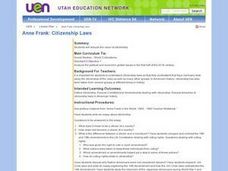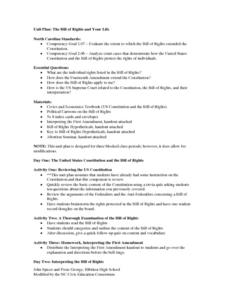Franklin D. Roosevelt Presidential Library & Museum
Developing Your Voice and Your Right to Free Speech
Three activities focus on the First Amendment, especially the freedom of speech. Scholars craft a letter to the President of the United States and express their views about a topic important to them. Another activity has participants...
Teacher Web
1920's Magazine
What a creative and engaging project to incorporate into your studies of the 1920s! Your young historians will work in groups to design a magazine discussing the political and cultural topics of the decade, each member writing one...
Curated OER
Anne Frank: Citizenship Laws
Students study early civilizations and the contributions they made to the foundations of human culture. They discuss why citizenship is valuable and the Constitutional Amendments that are associated with it.
Curated OER
The Bill of Rights and Your Life
Pupils review the contents of the Constitution by taking a trivia quiz and brainstorm the rights contained in the Bill of Rights. After discussing the Bill of Rights, students categorize and outline its content. Given a worksheet, pupils...
Curated OER
Reorganizing the Bill of Rights
Eighth graders, in groups, explore all 26 amendments and group them accordingly.
Curated OER
The Ongoing Debate: Crime Control v. Due Process Protection
Students investigate the Exclusionary Rule and other ways of to enforce the protections found in the Bill of Rights. They study how effective criminal control and public safety is carried out while citizens Constitutional rights are...
Curated OER
Constitutional Rights Of Students
Twelfth graders brief Supreme Court cases about student rights that they have studied over the past year, and apply them to a contemporary situation.
Curated OER
Arguments Against Ratifying the Constitution
Students define federalism, Federalist, and Anti-Federalist, debate issue of ratification in classroom convention, and take vote on whether to add bill of rights. Three lessons on one page.
Curated OER
Free to Speak and Free to Post?
Students research on the Web and in books with city statutes or call city officials to find out the local ordinance on posting signs on utility poles. If illegal, students explore what has happened elsewhere when citizens decided to...
Curated OER
Amendment Process
Eighth graders examine the current amendments and discuss any change they would like to make. With a partner, they develop a proposal and an advertisement to redo at least two amendments. They also compare and contrast the amendments...
Stanford University
Prohibition
Prohibition banned the selling of alcohol in America—but why? Designed for high school pupils, the lesson explores the causes of Prohibition including the Temperance Movement. The lesson pairs a PowerPoint presentation with worksheets...
Curated OER
The Bill of Rights and You
The right to life, liberty, and the pursuit of happiness. The instructional activity explains what the Bill of Rights is and how it applies to everyday life, like freedom of speech or the right to a jury trial. Young historians complete...
Carolina K-12
Citizens United v. Federal Election Commission & the First Amendment
Should Congress limit how much a corporation spends to support a political candidate? Here is a fantastic lesson plan and activities to help young citizens approach this question.
National Constitution Center
AP English Language—Argument
All things are subject to interpretation ... and that includes the Bill of Rights. Scholars work through activities to analyze and consider various interpretations and perspectives of the rights listed in the Constitution. They complete...
Curated OER
Constitution Day
In this U.S Constitution activity, students complete a crossword puzzle where they answer 20 questions about the U.S. Constitution then use their answers to complete a crossword puzzle. A word bank is provided.
Curated OER
U.S. Voting Amendments: Crossword Puzzle
In this United States history learning exercise, students use the 13 clues in order to fill in the crossword puzzle with the appropriate voting Amendment answers.
Curated OER
The Bill of Rights in Times of National Crisis
Students examine the ability of the government to suspend individual rights in times of national crisis. They formulate a constitutional amendment that clearly states if, when, how and by whom the rights of individuals can be suspended.
Curated OER
Supreme Court Case Study: District of Columbia Vs Heller
Examine the Supreme Court case, District of Columbia vs Heller, to build a better understanding of the Bill of Rights. Learners visit three different websites, read the provided informational text, and then answer a series of critical...
Curated OER
Ohio Statehouse History
Fourth graders examine the history of the Ohio Statehouse and order the major historical events in its development. The instructional activity traces the development from the time of Ohio's vast wilderness to the house's completion in 1861.
Curated OER
Free To Speak And Free To Post?
Learners research online and in books city statutes regarding posting signs on utility poles, interview appropriate officials about ordinances and how completely it is enforced, explore what has happened elsewhere when citizens decided...
Curated OER
Court Cases Testing the Establishment of Religion
Although the PowerPoint this lesson plan calls for is unavailable, you could easily create a presentation to fulfill its purpose. Learners listen to a presentation and keep track of the information with a graphic organizer that looks at...
Curated OER
Supreme Court Decisions and Their Effect On Us
Consider five Supreme Court cases and how their outcomes have directly affected the American population. Government students research and compose a 1-2 page pager outlining the examples of our daily life that have specifically been...
Curated OER
Supreme court Decisions on Freedom of Religion
Eleventh graders analyze the limits and bounds of religious freedom issues in the United States through several Supreme Court case decisions.
Curated OER
Religion in the Schools
The requirements of the Equal Access Act are studied and applied to factual situations. By looking at the particular contexts suggested your class can examine the difficulties faced by administrators in whether they should permit...

























